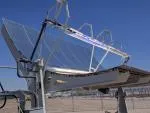Advanced Research in Optics Fuels University of Arizona's Prominence in Solar Technology


University of Arizona Professor of Optical Sciences Dr. Robert A. Norwood has been awarded $3.7 million dollars in two separate programs by the Department of Energy's Advance Research Programs Agency (ARPA-E) to make significant advances in the efficiency of both Photovoltaic (PV) and Concentrated Solar (CSP) technologies.
ARPA-E selects technology development projects based on their ability to enhance the nation’s economic and energy security. Successfully selected projects promise to help reduce energy-related emissions, improve energy efficiency in all economic sectors and ensure the United States maintains a technological advantage in developing and deploying advanced energy technologies.
"Dr. Norwood’s selection for two ARAPA-E projects is a testament to the outstanding value of his research in optics and photonics for the nation – but it also brings tremendous benefit to our students," notes Dean Thomas Koch, from the University’s College of Optical Sciences. "Dr. Norwood’s work exemplifies the vast contributions that Optical Sciences makes as an enabling technology for our future; in this case it is energy, but its impact ranges from national security to biomedicine, communications and entertainment technology."
Norwood’s solar energy work spans two specific technology development programs called FOCUS and MOSAIC.
FOCUS, Full Spectrum Optimized Collection and Utilization of Sunlight, seeks to create hybrid solar energy systems, which combine the best elements of both PV and CSP technologies to get the most out of the full solar spectrum, generating both electricity and heat within the same system. "The key to our approach in FOCUS is the design of a proprietary, dichroic mirror that spectrally separates the solar spectrum, sending the most efficient parts of the spectrum to the appropriate conversion technology mounted in an integrated unit," says Dr. Robert Norwood. The final milestone of the FOCUS program will be a demonstration of a prototype unit that has been installed at a satellite campus facility in west Tucson. "The demonstration should show successful and efficient collection of sunlight for both photovoltaic electricity and heat that can directly used or stored to enable the generation of electricity after the sun goes down."
The other program known as MOSAIC, or Micro-Scale Optimized Solar-Cell Arrays Integrated Concentration, seeks to develop technologies and concepts that will lower the cost of solar PV systems and improve their performance. PV systems currently generate about only 1.1 percent of the total power in the United States. For various reasons, existing PV technology will have to improve dramatically before the technology becomes economical enough for mainstream market adaptation. MOSAIC seeks to advance the efficiency of domestic use of PV through concentration (CPV) methods that use optical components to concentrate sunlight by more than 200 times into high efficiency solar sells, leading overall panel efficiencies exceeding 30 percent. "One of the chief limitations of solar energy is the large area that is required to generate useful amounts of energy; our MOSAIC program will enable cost effective reduction of this area by 50 percent," says Norwood.
The University of Arizona College of Optical Sciences, founded as the Optical Sciences Center, has been shaping the future since 1964 by offering high-quality instruction, cutting-edge research and a solid commitment to the development of the optics industry. OSC remains dedicated to providing the state of Arizona and the nation with an internationally pre-eminent program in all aspects of the study of light. For more information, please visit www.optics.arizona.edu or call 520-621-6997.
Graeme Hunt
Media Content Manager
520-626-4887
ghunt@optics.arizona.edu
